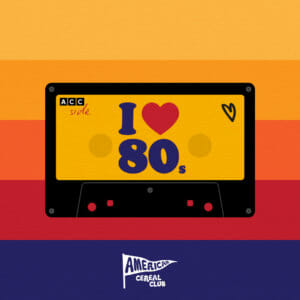For one of our clients, American Cereal Club, they weren’t just stepping into 2020, they were stepping into a whole new era. This fun, retro, sweet-loving brand like to change up their creative style by jumping between the decades and showcasing just how versatile their product is – the 70s, 80s, 90s, every era loves Malt-O-Meal® Marshmallow Mateys® cereal.
This also means their social content is kept fresh and fun, allowing us to create campaigns influenced by the era that they’re currently in and base their style on fashion and trends which were popular at that time.
From January 1st, American Cereal Club left the classic style of the 50s and skated straight into the fun-lovin’ 80s. We’re talking big, bold colours, legendary desserts and that undeniable love of big hair!
I’m going to look at this from a copywriting perspective, because, of course, with the 80s style comes new slang and old terms meaning the copy has got to shift slightly, to really portray that 80s feel. Of course, we don’t want to take it off-brand, the heart of the brand is still there so their copy needs to be recognisable, but it needs to fit with the era in which they’re currently residing!
The only way I can really describe a copy change is; Imagine being an actor/actress and having to switch character after the interval (ok, not so much the dress change, you can probably get by without that in the office), it can take a little while to get into the rhythm, pick up the accent and crack on with the script. Well, it’s pretty similar for writing content.
Not to be confused with the initial tone of voice creation for the brand, this should be firmly in place, however, these are some tips that I find helpful when adapting the current tone of voice to something a little different. Some may help, some may not be the ones for you, some of you may be an absolute pro already which, if that’s the case, you can probably stop reading here…
1. Do your research
Never underestimate the power of good research. No matter how well you think you know the 80s, more research is always going to help, and may just shed some light on your perception and reality.
Speaking from the context of ACC’s copy change, I found it helpful to research the slang phrases that were popular in the 80s and whether there were any new phrases that were created or influenced by the 80s.
Do some general research on life in the 80s – the popular films, the popular songs, the toys (what fires up nostalgia that people are going to relate to). This will help you to drop in well-known references, that you’d normally do if you were talking about the current day.

2. Clear your headspace
This may seem like the last thing you’re thinking about when you’ve got a 3pm deadline BUT, if you’re not in the right frame of mind, writing can be almost impossible, never mind thinking about a change in tone of voice. If you’ve just finished writing for a Yorkshire, down-to-earth foodie brand, switching this up to a fun, hip, 80s Cereal brand isn’t going to be the easiest thing to get into!
Take 5, grab a brew, step away from your laptop for a couple of minutes and come back with a clearer head.
2. Create a character
This is generally useful at the time of tone of voice creation but if you haven’t done it, it’s not too late! This will absolutely help you in the long run. It’s a lot easier to imagine yourself in a person’s shoes rather than as a brand on a whole – we are human after all. Even though the voice is attached to a brand, not a specific person, having a person in mind can make this a lot easier when speaking on behalf of a brand.
It can be a real person that you know or it can be a fictional character that you’ve created in your head. Personally, I find it easier to imagine real people that I know very well, as I can almost hear them in my head when reading my copy. That way, if you get stuck on a particular phrase you can think ‘how would my character/real-life person say it?’
It may even help to have a mini character bio to hand that you can quickly scan before jumping into character. Even something as simple as:
Name:
From:
Age:
Fave food:
Fave TV show:
Favourite words/phrases:

3. Listen to music from that time or that you can imagine your target audience listening to
If you’re not a person that listens to music whilst working, this may not be the one for you! However, if, like me, you prefer a bit of background noise to get you in the creative headspace, this one could be a winner!
Initially, it sounds like a pretty strange concept, however, I find listening to music (in ACC’s case) from that particular era really helps throw me into the right frame of mind. Subconsciously, I’m hearing phrases from the 80s that the audience is likely to be familiar with because they’re in well-known songs that the audience will have heard.
There isn’t too much more to say other than give it a go! If it’s not the one for you, then stick to your regular playlist, but if it is, you’ve just won yourself another little win that may help in the future.

4. Refer to your list of ‘words to use’ and ‘words not to use’
Whilst changing up the tone of voice slightly, it can be easy, and dangerous, to lose the initial tone of voice that you created for the client which holds their brand together and makes them the recognisable brand that they are. To avoid this from happening, keep a list of ‘words to use’ and ‘words not to use’ to hand.
Even if you’re not looking for a particular word or phrase, it may jog your memory on the other words they may say. If you don’t have one of these just yet, I’d suggest putting one together for future use. Using synonyms can be a good place to start, for example – would they say ‘simply beautiful’ or ‘down-right good’ or somewhere in the middle?
5. Read it out loud.
This one is a lot easier said than done, I get that. But, if you can get into the habit of reading your work out loud, this will help you get into character each time you’ve finished a paragraph/post. You’ll start to notice when something sounds strange, this may be because you hesitate or it doesn’t quite fit with the dialect that you’re trying to achieve. Read it a couple of times and the particular word/phrase will jump out at you.
This will also force you to speak in the accent that you’ve created for your character, in ACC’s case, what you perceive to be a dialect from the 80s! You’ll easily spot if something sounds amiss when you’re speaking as someone from that perspective.


